9 - LES BAMBOUS DU JARDIN BOTANIQUE ROYAL DE SYDNEY
9 LES BAMBOUS DU JARDIN BOTANIQUE ROYAL DE SYDNEY
par Robert Kernin
Note : Cet article fait partie du blog ‘Bambous passion’, que vous pouvez retrouver à l’adresse : http://www.pseudosasa.canalblog.com/
Photos 1et 2 - Entrée du jardin botanique – S’il vous plait, marchez sur les pelouses !- !!!

Note :
- Les noms des bambous cités dans cet article respectent les noms indiqués au jardin botanique.
- Pour les synonymes de chaque espèce, se reporter en fin d’article.
- Curseur sur photo pour légende, et cliquer pour agrandissement.
- Une version en anglais de cet article est disponible à la suite du texte français
An English translation is available at the following text in French.
On peut dire que l’histoire de ce jardin commence en 1788, avec le Gouverneur Arthur Philipp, et notamment par la construction d’une ferme céréalière, effectuée par l’un des hommes à son service, Henry Edward Dodd. Puis ont suivis divers évènements, en particulier la construction d’une route du temps du Gouverneur William Bligh, et achevée par le Gouverneur Lachlan Macquarie.
Le 13 juin 1816, du fait de l’achèvement de cette route le traversant, est reconnu pour le jour de la vraie naissance du jardin.
La ville a continuée à se construire autour, le situant de nos jours en plein cœur de la city et du quartier touristique. Il s’étend jusqu’en bordure de la baie de Sydney, juste derrière le très représentatif opéra (photo 3).
Il occupe une superficie de 30 hectares, et conserve, dans des locaux très appropriés, un herbier riche d’environ un million de spécimens !
A ce jour, 45 espèces de bambous y sont présentées, dans 14 genres.
- Arundinaria (2), Bambusa (18), Dendrocalamus (3), Drepanostachyum (1), Gigantochloa (5), Mullerochloa (1), Nastus (1), Neololeba (1), Phyllostachys (5), Pseudosasa (2), Rhipidocladium (1), Schizostachyum (2), Semiarundinaria (2), Thyrsostachys (1).
Je n’aborde dans cet article que 16 espèces, en espérant pouvoir un jour en faire un peu plus J
Je l’ai visité en août 2010, mois guère propice à la sortie des turions, c’est en effet l’hiver dans l’hémisphère sud.
Pour y voir les floraisons rouges, roses ou jaunes des eucalyptus, il faut également choisir une autre saison. L’un d’eux nous a offert tout de même sa floraison blanche, aux nectar et pollen très appréciés par une perruche multicolore, le loriquet à tête bleue - Trichoglossus haematodus - (photo 4). Le jardin était toutefois très fleuri d’autres espèces, comme vous pourrez le constater dans les photos de cet article.
Le jardin était toutefois très fleuri d’autres espèces, comme vous pourrez le constater dans les photos de cet article.
Le climat sur Sydney ne descend pas au dessous de 6°C, et monte en moyenne vers 26°C, mais des températures de 40 degrés et même plus peuvent être atteintes en été. Ces minima et maxima permettent l’acclimatation de certaines espèces tropicales, comme j’ai pu le voir au niveau des bambous.
Afin d’être bien orienté et conseillé, j’avais pris contact avec Simon Goodwin, qui nous a consacré, à mon épouse et moi-même, une grande partie de la journée. Un second botaniste du jardin, Dawson Ougham, s’est joint à nous, avant de commencer la visite des bambous avec un spécimen d’une grande importance, puisque il s’agissait de l’une des trois espèces originaires d’australie, Neololeba atra (photo 5). On trouve cette espèce dans la péninsule du Cap York, à l’extrême nord du Queensland. Pouvant atteindre une hauteur de 5m, il possède de très grandes feuilles. Les gaines de chaume, pubescentes sur leur face externe, présentent une ligule et des oreillettes ornées de longs cils (photos 6, 6a, 7 et 8).
On trouve cette espèce dans la péninsule du Cap York, à l’extrême nord du Queensland. Pouvant atteindre une hauteur de 5m, il possède de très grandes feuilles. Les gaines de chaume, pubescentes sur leur face externe, présentent une ligule et des oreillettes ornées de longs cils (photos 6, 6a, 7 et 8).



Les gaines foliaires sont elles aussi ornées de cils (photo 9). La languette de gaine est très large (photo 10).
La languette de gaine est très large (photo 10). Une température de 0°C serait tolérée pour ce bambou, mais il vit essentiellement en zone tropicale à des altitudes avoisinant les 1250m. On le trouve aussi en Papouasie Nouvelle-Guinée et dans l’Irian Jaya. Au jardin botanique, un plant est en acclimatation en extérieur et un autre est conservé sous serre (photo 11).
Une température de 0°C serait tolérée pour ce bambou, mais il vit essentiellement en zone tropicale à des altitudes avoisinant les 1250m. On le trouve aussi en Papouasie Nouvelle-Guinée et dans l’Irian Jaya. Au jardin botanique, un plant est en acclimatation en extérieur et un autre est conservé sous serre (photo 11).
Je n’ai pu voir aucun turion, mais je reviendrai sur cette espèce dans un prochain article concernant le jardin botanique de Singapour, que j’ai visité quelques jours plus tard, avec un turion en prime !
La deuxième espèce rencontrée, maintenue essentiellement sous serre, est endémique d’Australie. Il s’agit de Mullerochloa moreheadiana, bambou grimpant, qui pourrait atteindre le sommet des grands arbres de 60m de haut ! j’ai pu voir des chaumes d’environ 1cm de diamètre (photo 12), mais de plus fortes dimensions sont supposées, jusqu’à 3 cm.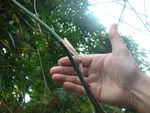
Sur la photo 13, on peut voir quatre ou cinq chaumes prenant naissance en terre, de part et d’autre de l’arbre. Attention, les plantes grimpantes collées le long du tronc ne sont pas des bambous, bien qu’y ressemblant de loin.
on peut voir quatre ou cinq chaumes prenant naissance en terre, de part et d’autre de l’arbre. Attention, les plantes grimpantes collées le long du tronc ne sont pas des bambous, bien qu’y ressemblant de loin.
On peut noter la forme arquée des entrenoeuds (photo 14),
les feuilles ‘froissées/parcheminées’(photo 15), mais ceci étant peut-être dû aux conditions de maintenance. Une gaine de chaume sur le point de tomber (photo 16)
mais ceci étant peut-être dû aux conditions de maintenance. Une gaine de chaume sur le point de tomber (photo 16) laisse apercevoir une partie du nœud, et on peut aussi constater une pilosité parsemée mais régulière sur les entrenoeuds.
laisse apercevoir une partie du nœud, et on peut aussi constater une pilosité parsemée mais régulière sur les entrenoeuds.
La troisième espèce originaire d’Australie n’est pas conservée au jardin de Sydney. A titre d’information, il s’agit de Bambusa arnhemica, endémique, et on la trouve au nord, dans la région de Darwin, et celle d’Arnhemland, d’où son nom. Sa taille atteindrait entre 10 et 20 m.
Quittant la serre, nous croisons Bambusa multiplex sous forme de quelques belles touffes, ainsi que Bambusa vulgaris cv.striata (photo 17)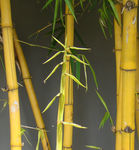 , espèce incontournable des jardins tropicaux. Sur les pelouses, ou chacun peut s’installer et apporter son pic nique, déambulent des ibis blancs à coup noir-Threskiornis molucca- (photo 18)
, espèce incontournable des jardins tropicaux. Sur les pelouses, ou chacun peut s’installer et apporter son pic nique, déambulent des ibis blancs à coup noir-Threskiornis molucca- (photo 18) que nous verrons d’ailleurs partout dans la ville. Un arbre curieux au tronc en forme de bouteille attire notre attention, c’est une espèce que l’on trouve dans le Queensland -Brachychiton rupestris- (photo 19).
que nous verrons d’ailleurs partout dans la ville. Un arbre curieux au tronc en forme de bouteille attire notre attention, c’est une espèce que l’on trouve dans le Queensland -Brachychiton rupestris- (photo 19). Une pensée à ceux qui maintiennent en état l’étiquetage du jardin, bravo, voilà qui évite bien des recherches !
Une pensée à ceux qui maintiennent en état l’étiquetage du jardin, bravo, voilà qui évite bien des recherches !
Nous nous dirigeons vers la partie du jardin plus particulièrement destinée aux bambous.
Le premier pied sera Bambusa membranacea (photos 20,21 et 22).

 Grande espèce pouvant atteindre 24 m, son aire de distribution est vaste, Burma, Thailande,Laos et Chine. Je remarque le bas des chaumes gravé, comme le seront beaucoup dans le jardin, dommage pour les photographes…mais quel bois formidable pour les amoureux !!! Ce bambou est surnommé ‘bambou blanc’, en rapport avec le vieillissement des chaumes laissant apparaître le bois blanc.
Grande espèce pouvant atteindre 24 m, son aire de distribution est vaste, Burma, Thailande,Laos et Chine. Je remarque le bas des chaumes gravé, comme le seront beaucoup dans le jardin, dommage pour les photographes…mais quel bois formidable pour les amoureux !!! Ce bambou est surnommé ‘bambou blanc’, en rapport avec le vieillissement des chaumes laissant apparaître le bois blanc.
Puis apparaît un bambou formidable, le surprenant Gigantochloa sp.’Timor Black’, aux chaumes d’un noir brillant (photo 23) , parfois superbement rayés de vert. (photo visible dans prochain article sur le jardin de Singapour). Cette espèce, comme certains cultivars de Phyllostachys nigra, passe par plusieurs phases de colorations des chaumes. Le nouveau chaume est vert, puis devient noir profond, puis le noir devient terne et enfin la cuticule disparaît peu à peu par endroits, donnant au chaume une teinte blanchâtre (photos 24 et 25).
, parfois superbement rayés de vert. (photo visible dans prochain article sur le jardin de Singapour). Cette espèce, comme certains cultivars de Phyllostachys nigra, passe par plusieurs phases de colorations des chaumes. Le nouveau chaume est vert, puis devient noir profond, puis le noir devient terne et enfin la cuticule disparaît peu à peu par endroits, donnant au chaume une teinte blanchâtre (photos 24 et 25).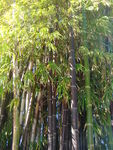
 Le port général est droit, les branches courtes (photo 26).
Le port général est droit, les branches courtes (photo 26). Les feuilles sont assez fines et longues (photo 27).
Les feuilles sont assez fines et longues (photo 27).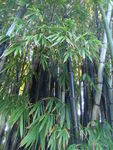 Ce bambou est particulièrement apprécié, au jardin de Sydney, par les ‘graveurs de cœur’ (photo 28) J.
Ce bambou est particulièrement apprécié, au jardin de Sydney, par les ‘graveurs de cœur’ (photo 28) J. Sa taille est donnée pour 15m (21m autre source) pour des diamètres de 8 à 10cm, cette espèce serait originaire de l’île de Timor, dans l’archipel Indonésien, qui lui a donné son surnom. Son aire de distribution pourrait s’étendre de l’Indonésie (Timor et Java en particulier, Sumatra) à la Malaisie, mais la confusion faite avec G. atroviolacea (G.atroviolacea var.nigra) laisse un flou. Maintenant en culture dans divers autres pays (Australie, Etats-Unis).
Sa taille est donnée pour 15m (21m autre source) pour des diamètres de 8 à 10cm, cette espèce serait originaire de l’île de Timor, dans l’archipel Indonésien, qui lui a donné son surnom. Son aire de distribution pourrait s’étendre de l’Indonésie (Timor et Java en particulier, Sumatra) à la Malaisie, mais la confusion faite avec G. atroviolacea (G.atroviolacea var.nigra) laisse un flou. Maintenant en culture dans divers autres pays (Australie, Etats-Unis).
En 1997, il a été placé dans le genre Bambusa, prenant le nom de Bambusa Lako, par la botaniste Elizabeth A.Widjaja. Cependant aucune floraison n’a pu être observée de nos jours, qui permettrait de conforter ou non ce nouveau genre, et de plus récentes observations (en 2000) n’excluent pas de le voir réintégrer le genre Gigantochloa. Un détail intéressant, il supporterait des froids de - 4°C. En sachant la variété des climats tropicaux d’origine, selon l’altitude notamment, et l’exposition solaire, ce serait une belle expérience à tenter dans certains coins du bord de mer du midi de la France.
Le bambou suivant, Bambusa oldhamii (photo 29), possède un port très érigé. Les feuilles sont petites, et un peu parcheminées (photo 30).
possède un port très érigé. Les feuilles sont petites, et un peu parcheminées (photo 30). Les chaumes sont verts, mais une pruine abondante, farineuse, recouvre les entrenoeuds des nouveaux chaumes (photo 31),
Les chaumes sont verts, mais une pruine abondante, farineuse, recouvre les entrenoeuds des nouveaux chaumes (photo 31), leur donnant une teinte vert bleu. Les gaines de chaume sont munies d’une languette très large à sa base (photo 32).
leur donnant une teinte vert bleu. Les gaines de chaume sont munies d’une languette très large à sa base (photo 32). Cette espèce est originaire de la Chine du sud-est. Sa taille varie beaucoup selon les sources, de 6 à 20m ! Pour un diamètre de 10cm. Peut-être cette espèce est-elle plus sensible que d’autres à son environnement, ou bien est ce le fait qu’elle soit très répandue en culture dans beaucoup de pays, d’où des conditions différentes de sol, températures et climats.
Cette espèce est originaire de la Chine du sud-est. Sa taille varie beaucoup selon les sources, de 6 à 20m ! Pour un diamètre de 10cm. Peut-être cette espèce est-elle plus sensible que d’autres à son environnement, ou bien est ce le fait qu’elle soit très répandue en culture dans beaucoup de pays, d’où des conditions différentes de sol, températures et climats.
La rencontre de ce bambou au jardin botanique de Sydney m’a apporté une très bonne nouvelle, puisque j’ai pu reconnaître, au vu des nombreuses photos générales et de détails, ainsi qu’aux notes prises, l’une des espèces de l’île de Wallis, espèce présente dans un terrain consacré à l’administration de l’agriculture, et que j’avais référencée sous le nom de ‘Wallis sp.2 jard.agric ‘en 2009 (voir l’article « Wallis et Futuna- Mode de vie,faune, flore et …bambous » mai 2009). Elle atteint sur cette île une taille de 12/13m, et aurait été plantée, au moment de mes observations, depuis 10 ans environ, donc ‘adulte’. Année de plantation vers 1998/99.
Un peu plus loin apparaît un bambou aux feuilles longues et fines. Des gaines de chaume persistantes, sur des chaumes fins comparativement à leur hauteur, il s’agit de Thyrsostachys siamensis. Cette espèce a marqué, par son port et son feuillage, notre ami de l’AEB Michel Bonfils, qui m’en avait parlé un jour d’une manière passionnée. Maintenant que j’ai ce bambou sous les yeux, je le comprends (photo 33)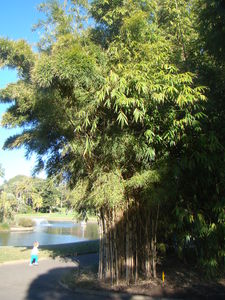 - attention, les feuilles plus larges apparaissant au centre et en haut de la photo sont celles d’une autre espèce, alors que le feuillage de T.siamensis est bien visible en majorité sur la gauche. Le feuillage est d’une finesse remarquable (photo 34)
- attention, les feuilles plus larges apparaissant au centre et en haut de la photo sont celles d’une autre espèce, alors que le feuillage de T.siamensis est bien visible en majorité sur la gauche. Le feuillage est d’une finesse remarquable (photo 34) , les gaines de chaume sont plus longues que l’entrenoeud (photo 35),
, les gaines de chaume sont plus longues que l’entrenoeud (photo 35), présence d’un anneau de pruine blanche sous le nœud (photo 36),
présence d’un anneau de pruine blanche sous le nœud (photo 36), et on peut noter sur cette même photo que la frontière entre la gaine de chaume et la languette de gaine est très discrètement marquée, en forme d’arc prononcé, les côtés de l’arc tournés vers le bas. Les branches sont en général très érigées (photo 37).
et on peut noter sur cette même photo que la frontière entre la gaine de chaume et la languette de gaine est très discrètement marquée, en forme d’arc prononcé, les côtés de l’arc tournés vers le bas. Les branches sont en général très érigées (photo 37). Il peut atteindre une hauteur variant de 8 à 14m, selon son environnement, pour un diamètre de chaume autour des 7 cm maxi.
Il peut atteindre une hauteur variant de 8 à 14m, selon son environnement, pour un diamètre de chaume autour des 7 cm maxi.
Son aire de distribution comprend le Burma, la Thaïlande, la Chine, et on le rencontre fréquemment en culture en Malaisie, sa présence étant noté également en Indonésie (je pense que ce sont des pieds de cette espèce que j’ai vu fréquemment près des maisons à Bali, ou du , moins une autre espèce de Thyrsostachys), en Inde, à Taiwan et au Bangladesh. Il est aussi présent à Singapour (jardin botanique et parc ornithologique). Un pied est visible en France, maintenu sous la grande serre, au parc Phoenix de Nice.
Planté juste à la suite, un bambou aux chaumes verts striés d’ivoire, sorte de blanc crème tirant vers le jaune pâle … Bambusa longispiculata expose ses chaumes et ses charmes, comme une peinture, superbe ! (photos 38 et 39).
 Le haut des chaumes passe progressivement à la couleur verte (photo 40).
Le haut des chaumes passe progressivement à la couleur verte (photo 40).
Un anneau de pruine blanche marque la partie supérieure du nœud (photo 41),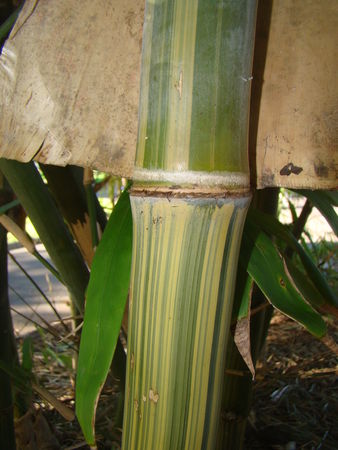 Le bourgeon, qui donnera naissance aux branches, est en forme d’œuf, du moins dans la partie basse des chaumes (photos 42 et 43).
Le bourgeon, qui donnera naissance aux branches, est en forme d’œuf, du moins dans la partie basse des chaumes (photos 42 et 43).

Les feuilles sont de taille variable, moyennes à grandes, de 9 à 30 cm (photo 44).
Espèce originaire de l’Inde, du Bangladesh et du Burma, sa taille peut atteindre 15m pour un diamètre de 8cm.
Le pied suivant s’avère être Bambusa vulgaris cv.Wamin (photo 45), aux chaumes parfois renflés en partie inférieure (photo 46).
aux chaumes parfois renflés en partie inférieure (photo 46).
Les gaines tombantes laissent leur cicatrices au niveau des nœuds (photo 47)
et la base des chaumes, lorsqu’elle est dénudée, laisse apparaître parfois d’étranges sculptures (photo 48).
Les turions, selon leur grosseur, ou bien parfois s’ils vont avorter, peuvent revêtir des aspects bien différents (photos 49 et 50),
 comme d’ailleurs dans d’autres espèces.
comme d’ailleurs dans d’autres espèces.
Ce cv. de Bambusa vulgaris est assez fréquent dans les jardins botaniques des pays tropicaux, vu l’aspect particulièrement décoratif de ses chaumes. L’espèce type, B.vulgaris, est répandue dans la plupart des pays de climat tropical ou équatorial.
Le bambou suivant est Gigantochloa albociliata. La touffe a été sérieusement taillée, si bien qu’il ne rest que 3 ou 4 chaumes, et d’une taille modeste. Cette espèce présente elle aussi des chaumes rayés d’ivoire tirant parfois vers le jaune (photo 51), mais les gaines de chaume sont couvertes en partie de poils bruns très fournis (photo 52) ),
mais les gaines de chaume sont couvertes en partie de poils bruns très fournis (photo 52) ), contrairement à l’espèce précédente.. Les chaumes ne poussent pas droits mais inclinés dans toutes les directions, occupant dans l’air un espace important. Leur hauteur varie de 6 à 10m, pour des diamètres moyens de 4 à 5 cm.
contrairement à l’espèce précédente.. Les chaumes ne poussent pas droits mais inclinés dans toutes les directions, occupant dans l’air un espace important. Leur hauteur varie de 6 à 10m, pour des diamètres moyens de 4 à 5 cm.
Son aire de répartition est signalée en Inde (Bengale et Assam entre autres), au Bangladesh, au Burma, en Thaïlande, au Laos et au Vietnam. On le trouve également en Chine ( région du Xishuangbanna dans la province duYunnan, frontalier du Laos).
Avec Dendrocalamus latiflorus cv.Mei Nung, on passe à une autre dimension de bambou. Un ‘gros’, aux chaumes d’un beau jaune prononcé, rayé de vert (photo 53). Le port général donne un bambou dressé (photo 54).
Le port général donne un bambou dressé (photo 54).  Sur cette même photo 54, on peut remarquer que le nouveau chaume, sur la gauche de la touffe, et allant jusqu’au sommet de celle-ci, est cassé à son extrémité (on peut voir la partie cassée qui pend). Simon m’explique que cette cassure est due aux opossums, qui s’en prennent aux pousses tendres, et que l’on peut observer de nuit dans le jardin, ainsi d’ailleurs que dans d’autres parcs de la ville.
Sur cette même photo 54, on peut remarquer que le nouveau chaume, sur la gauche de la touffe, et allant jusqu’au sommet de celle-ci, est cassé à son extrémité (on peut voir la partie cassée qui pend). Simon m’explique que cette cassure est due aux opossums, qui s’en prennent aux pousses tendres, et que l’on peut observer de nuit dans le jardin, ainsi d’ailleurs que dans d’autres parcs de la ville.
Les nouveaux chaumes (au centre de la photo 55), ne possèdent pas les couleurs éclatantes des plus anciens, celle-ci étant plus terne, plus diffuse. La couleur devient donc plus prononcée avec le temps. Les feuilles sont grandes et larges (photo 56).
ne possèdent pas les couleurs éclatantes des plus anciens, celle-ci étant plus terne, plus diffuse. La couleur devient donc plus prononcée avec le temps. Les feuilles sont grandes et larges (photo 56). Je ne résiste pas à zoomer sur les chaumes J (photo 57).
Je ne résiste pas à zoomer sur les chaumes J (photo 57).
Ce cultivar est très répandu à Taiwan. Il peut atteindre des hauteurs de 24m, pour un diamètre de 25 cm. Le plan du Jardin Botanique de Sydney, sans atteindre cette taille, est très impressionnant.
Situé bien à l’écart des autres bambous, nous allons ensuite voir une grande espèce, Bambusa balcooa (photo 58). La touffe comprend de nombreux chaumes anciens et secs, pas très aisé pour de bonnes photos, mais un chaume récent (photo 59)
La touffe comprend de nombreux chaumes anciens et secs, pas très aisé pour de bonnes photos, mais un chaume récent (photo 59)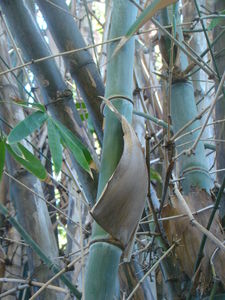 me permettra de voir une particularité des nœuds, qui sont excentrés du côté du bourgeon (photo 60),
me permettra de voir une particularité des nœuds, qui sont excentrés du côté du bourgeon (photo 60), celui-ci étant d’une taille très forte (photo 61) et assez proéminent.
celui-ci étant d’une taille très forte (photo 61) et assez proéminent.
Ce bambou serait originaire de l’Inde, on le trouve aussi au Népal, au Bhoutan et au Bangladesh.
En culture dans de nombreux pays asiatiques, ainsi qu’en Afrique du Sud et en Australie.
Il peut atteindre une taille de 20m pour un diamètre de 15 cm.
Un bambou de taille plus modeste a été planté non loin de l’espace réservé plus particulièrement aux agavacées. Il s’agit de Semiarundinaria Yashadake, espèce originaire du Japon (photo 62). Un port très droit avec des branches courtes, il peut atteindre, dans de bonnes conditions et un climat propice, une taille de 7 à 8m, pour des diamètres autour des 4cm. La touffe que j’ai sous les yeux présente des chaumes un peu plus plus modestes. Il s’agit d’une espèce traçante, qui est ici bien contenue.
Un port très droit avec des branches courtes, il peut atteindre, dans de bonnes conditions et un climat propice, une taille de 7 à 8m, pour des diamètres autour des 4cm. La touffe que j’ai sous les yeux présente des chaumes un peu plus plus modestes. Il s’agit d’une espèce traçante, qui est ici bien contenue.
La dernière espèce que nous allons voir se situe en dehors du Jardin Botanique, non loin de la ‘’ART GALLERY OF NEW SOUTH WALES’’. Il y a le long du boulevard un petit jardin, entouré de murs et d’une grille, dans lequel se trouvent deux espèces : Bambusa vulgaris cv.Wamin, que l’on a déjà vu dans le Jardin Botanique, et Drepanostachyum falcatum (photo 63), un bambou originaire du Népal, de l'Inde et du Pakistan.
un bambou originaire du Népal, de l'Inde et du Pakistan.
La hauteur du plant de ce petit jardin doit se situer vers les2 m, mais cette espèce peut atteindre 4 m pour un diamètre de 1.5 cm, donc des chaumes très fins.
Les feuilles sont d’une finesse extrême, autour des 8cm pour une largeur de 0,5cm.
Avec ce dernier se termine la partie bambou de cet article.
Très intéressé par les eucalyptus, j’ai eu le plaisir de voir une espèce, dont il restait seulement 3 arbres en 2003 recensés dans le New South Wales, et qui a fait l’objet d’un programme de sauvegarde. Il s’agit d’Eucalyptus copulans (photo 64) , planté au jardin tout près de la partie consacrée aux cactées.
, planté au jardin tout près de la partie consacrée aux cactées.
Pour finir cet article, voici une vingtaine de photos de plantes diverses, aloes, agaves, et diverses espèces, ainsi que quelques vues du Jardin, et une photo d’un Cacatoes galerita, espèce vivant libre et en groupes dans le jardin et dans cette partie de l’Australie, que nous avons aperçu également dans les Blue Mountains (à une heure de Sydney en voiture), allant jusqu’à se poser sur l’épaule des promeneurs du jardin, puis une vue sur les grandes roussettes australiennes perchées (ou plutôt pendues) dans les hautes branches au dessus de nos têtes. 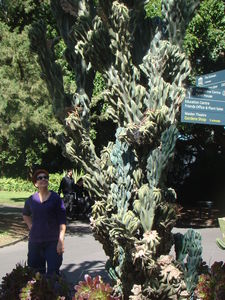
En cliquant sur les photos les noms apparaissent.
Un grand merci à SimonGoodwin et à Dawson Ougham, pour leur accueil et le temps qu’ils nous ont consacrés, pour tout ce qu’ils nous ont appris sur le Jardin Botanique, et pour le partage de cette passion des plantes que j’ai ressenti en leur compagnie...ainsi que pour les conseils dans la rédaction de cet article :)
Synonymes des bambous cités : ( synonymes les plus courants)
1- Neololeba atra = Bambusa forbesii
2- Mullerochloa moreheadiana = Dinochloa moreheadiana = Bambusa moreheadiana
3- Bambusa arnhemica = pas de synonyme
4- Bambusa multiplex = Bambusa glaucescens
5- Bambusa vulgaris cv.Vittata = Bambusa vulgaris cv.Striata
6- Bambusa membranacea = Dendrocalamus membranaceus
7- Gigantochloa sp.Timor Black = Bambusa Lako
8- Bambusa oldhamii = Dendrocalamus oldhamii = Leleba oldhamii
9- Thyrsostachys siamensis = Thyrsostachys regia = Bambusa regia
10- Bambusa longispiculata = Bambusa thouarsii
11- Bambusa vulgaris cv.Wamin = Bambusa wamin
12- Gigantochloa albociliata=Oxytenanthera albociliata=Pseudoxytenanthera albociliata
13- Dendrocalamus latiflorus cv.Mei Nung = Sinocalamus latiflorus (pour le type)
14- Bambusa balcooa = Dendrocalamus balcooa
15- Semiarundinaria Yashadake = Arundinaria narihira
16- Drepanostachyum falcatum = Sinarundinaria falcata
Bibliographie :
- Grasses, Bamboos and Related Plants in Australia – Nick Romanowski – 1993
- The bamboos of the world – D.Ohrnberger – 1999
- Bambous en France – J.P.Demoly – 1996.-.
- Bamboos of Nepal – Chris Stapleton – 1994.
- Bamboos of Bhutan - Chris Stapleton - 1994.
- Bamboo for Gardens – Ted Jordan Meredith – 2001.
- Bamboo World – Victor Cusack (photographs by Deirdre Stewart) – 1999.
- Les Bambusees – E.G.Camus – 1913. (Réédition de 1979).
- The Bamboos of Sabah – Soejatmi Dransfield – 1992.
- Bamboos of the Chitou Forest Recreation Area – The Experimental Forest, College of
Agriculture, National Taiwan University – 1980.
- Bamboos of India, a compendium - K.K.Seethalakshmi and M.S.Muktesh Kumar – 1998.
- A Compendium of Chinese Bamboo – China Forestry Publishing House- 1994-
- The Horticultural Bamboo Species in Japan - Hata Okamura - Yukio Tanaka - 1986;
Photos : Rékia et Robert Kernin Date de l’article : mai 2011
THE BAMBOO ROYAL BOTANIC GARDEN OF SYDNEY
by Robert Kernin
Photos 1 and 2 - Entering the botanical garden - Please, walk on the grass-!
Note:
The names of bamboos cited in this article follow the names given to the botanical garden.
Synonyms for each species, see end of article.
We can say that the history of this garden began in 1788, with Governor Arthur Phillip, including the construction of a grain farm, carried out by one of the men in his service, Henry Edward Dodd. Then have followed various events, especially the construction of a road in the time of Governor William Bligh, and completed by Governor Lachlan Macquarie.
On June 13, 1816, due to the completion of this road passing through it, is recognized for the day of the true birth of the garden.
The city has continued to build around, placing it today in the heart of the city and tourist areas. It extends to the edge of Sydney Harbour, just behind the opera very representative (photo 3).
It occupies an area of 30 hectares, and retains, in places very appropriate, a rich herbarium of about one million specimens!
To date, 45 species of bamboo are presented in 14 genera.
- Arundinaria (2), Bambusa (18), Dendrocalamus (3), Drepanostachyum (1), Gigantochloa (5), Mullerochloa (1), Nastus (1), Neololeba (1), Phyllostachys (5), Pseudosasa (2), Rhipidocladium (1), Schizostachyum (2), Semiarundinaria (2), Thyrsostachys (1).
I address in this article that 16 species, hoping to someday do a little more
I visited in 2010, the 18 and 20 August, months not conducive to the output of the shoots, it is indeed winter in the southern hemisphere.
To see blooms red, pink or yellow of eucalyps, it must also choose a different season. One of them gave us all the same its white flowers, with nectar and pollen appreciated by a multicolored parrot, the rainbow lorikeet - Trichoglossus haematodus - (Photo 4). The garden was however very flowery other species, as you can see from the photos in this article.
The climate in Sydney does not drop below 6 ° C, and amounts on average to 26 ° C, but temperatures of 40 degrees and even more can be achieved in the summer. These minimum and maximum possible acclimation of some tropical species, as I have seen in bamboo.
To be properly guided and advised, I made contact with Simon Goodwin, who has devoted to my wife and myself, much of the day. A second botanical garden, Dawson Ougham, joined us, before starting the visit of bamboo with a specimen of great importance, since it was one of the three species from Australia, Neololeba atra (Fig. 5). This species is found in the Cape York Peninsula, far north Queensland. Up to a height of 5m, it has very large leaves. Culm sheat, hairy on the outside, have a ligule and auricles adorned with long oral setae (photos 6, 6a, 7 and 8). The leaf sheaths are also decorated with cilia (Photo 9). The blade of culm sheath is very wide (photo 10). A temperature of 0 ° C would be tolerated for bamboo, but lived mainly in tropical areas at altitudes of around 1250m. It is also found in Papua New Guinea and Irian Jaya. The botanical garden, a plant is outdoors acclimation and another is kept under greenhouses (photo 11).
I could see no shoot, but I shall return to this case in a forthcoming article on the Singapore Botanic Garden, which I visited a few days later, with a new shoot as a bonus!
The second species encountered, mainly in greenhouses maintained, is endemic to Australia. These Mullerochloa moreheadiana, climbing bamboo, which could reach the top of tall trees 60m high! I could see culms of about 1cm in diameter (Photo 12), but higher dimensions are assumed, up to 3 cm. On the picture 13, we can see four or five culm begin to land, either side of the tree. The foliage is visible at the top. Please note, stuck climbing plants along the trunk are not bamboos, although resembling what further.
We can note the arched shape of the internodes (photo 14), leaves, crumpled
/ wrinkled '(photo 15), but this is perhaps due to maintenance requirements. A sheath culm of stubble fall down (photo 16) lets see some of the node, and one can also see a steady but scattered hairs on internodes.
The third species native to Australia is not conserved in the garden of Sydney. For information, it is Bambusa arnhemica, endemic, and is found north in the Darwin region, and that of Arnhemland, hence its name. Its size would reach between 10 and 20 m.
Leaving the greenhouse, we meet Bambusa multiplex as a few nice clumps and Bambusa vulgaris cv.striata (photo 17), a species must tropical gardens. On the lawns, where everyone can settle down and provide picnic, stroll the white ibis black move-Threskiornis Molucca-(photo 18), we see elsewhere around town. A tree trunk curious bottle-shaped draws our attention is a species found in Queensland Brachychiton rupestris--(photo 19). A thought for those that keep state labeling of the garden,” bravo, "that avoids a lot of research!
We head towards the garden especially designed for bamboo.
The first leg will Bambusa membranacea (photos 20,21 and 22). Large species can reach 24 m, its range is vast, Burma, Thailand, Laos and China. I notice the culm burned down, as will many in the garden, too bad for photographers ... but what a wonderful timber for lovers! This bamboo is known as 'bamboo white' in connection with the aging of culm exposing the white wood.
Then a bamboo appears formidable, the surprising Gigantochloa sp. 'Timor Black', with a shiny black culm (photo 23), sometimes beautifully striped green (visible in photo section next to the garden of Singapore). This species, like some varieties of Phyllostachys nigra, goes through several phases of coloration culm. Thatch is the new green, then turns deep black, then black and finally becomes dull cuticle gradually disappears in places, giving a whitish culm (photos 24 and 25). The general habit is upright, the branches short (photo 26). The leaves are fairly thin and long (Photo 27). This bamboo is particularly popular in the garden of Sydney, for the 'Writers heart'(photo 28) J. Its size is given for 15m (21m other source) for diameters from 8 to 10cm, this species is native to the island of Timor in the Indonesian archipelago, which gave him his nickname. Its range could extend from Indonesia (particularly Java and Timor, Sumatra) to Malaysia, but the confusion with G. atroviolacea (G.atroviolacea var.nigra) leaves a blur. Now grown in various other countries (Australia, USA).
In 1997, he was placed in the genus Bambusa, taking the name Bambusa Lako, bye the botanist Elizabeth A. Widjaja. However, no flowering was observed today, which would confirm or not this new genre, and more recent observations (2000) do not rule out return to see the kind Gigantochloa. An interesting detail, it supports cold - 4 ° C. Knowing the variety of tropical climates of origin, especially with the altitude, and sun exposure, it would be a nice experience to try in some corners of the seaside in the south of France.
The following bamboo, Bambusa oldhamii (photo 29), has built a thriving port.
The leaves are small and slightly wrinkled (photo 30). The culms are green, but an abundant bloom flour, cover the internodes of new culms (photo 31), giving them a green tint blue. The culm sheath are fitted with a blade very broad at its base (Photo 32). This species is native to China's southeast. Its size varies widely by source, from 6 to 20m! For a diameter of 10cm. Perhaps this species is more sensitive than others in its environment, or is it the fact that it is widely grown in many countries where different conditions of soil temperatures and climates.
The meeting of that bamboo in the botanical garden in Sydney gave me a very good news, since I could recognize, in view of the many pictures and general information, as well as notes, one species of Island Wallis species present in a field devoted to the administration of agriculture, and that I referenced in the name of ‘Wallis sp.2 jard.agric’ in 2009 (see Article 1 of this blog "Wallis and Futuna-Lifestyle, fauna, flora and bamboo ..." May 2009). She reached on the island size 12/13m, and was planted at the time of my observations about 10 years, so 'adult'. Planting year to 1998/99.
A little further on is a bamboo leaves long and slender. Sheaths persistent culm, culm height compared to their purposes, this is Thyrsostachys siamensis. This species was marked by its port and its foliage, our friend from the AEB Michel Bonfils, who told me about one day a passionate way. Now that I have this bamboo in my eyes, I understand ... (photo 33) - attention, the larger leaves, appearing at the top center of the photo are those of another species whereas the leaves of T. siamensis is visible mostly on the left. The foliage is remarkably fine (photo 34), culm sheath are longer than the internode (photo 35), presence of a ring of white bloom in the node (photo 36), and it may be noted on same photo as the boundary between the sheath and blade sheath is very discreetly marked, pronounced bow-shaped, the sides of the bow facing down. The branches are generally very upright (photo 37). It can reach a height of 8 to 14m, depending on its environment, with a diameter of 7 cm stubble around max.
Its range includes Burma, Thailand, China, and is commonly found in cultivation in Malaysia, its presence was also noted in Indonesia (I think these are the feet of this species that I have frequently seen near houses in Bali, or at least another species of Thyrsostachys), India, Taiwan and Bangladesh. It is also present in Singapore (botanical garden and bird park). One foot is visible in France, kept under greenhouse at Phoenix Park in Nice.
Planted just after a green bamboo culms striped with ivory, a kind of creamy white to pale yellow drawing ... Bambusa longispiculata exhibited his culms and his charms, like a painting, beautiful! (photos 38 and 39). The high culm gradually changes to green (photo 40). A ring of white bloom marks the upper node (photo 41), the bud, which will give rise to branches, is egg-shaped, at least in the lower part of culms (photos 42 and 43). The leaves vary in size, medium to large, from 9 to 30 cm (Photo 44).
Species native to India, Bangladesh and Burma, its size can reach 15m and a diameter of 8cm.
The foot appears to be following Bambusa vulgaris cv.Wamin (photo 45), with culms sometimes swollen at the bottom (photo 46). The culm sheaths falling leave their scars at the nodes (photo 47) and the base of the culm, when stripped, reveals some strange sculptures (photo 48).
Shoots, depending on their size, or sometimes they will abort, can take on very different aspects (photos 49 and 50), as indeed in other species.
This cv. Bambusa vulgaris is of fairly frequent in the botanical gardens of tropical countries, given the particularly its decorative culms. The type species, B.vulgaris, is widespread in most countries of tropical or equatorial.
The following is Gigantochloa albociliata bamboo. The tuft was severely cut, so there are only 3 or 4 culm, and a modest size. This species also culm striped ivory sometimes firing towards yellow (photo 51), but the culm sheath are covered with thatch of brown hair partly very provided (photo 52), unlike the preceding species. The culm does not grow right but inclined in all directions, occupying a space in air important. Their height varies from 6 to 10m, for average diameters of 4 to 5 cm.
Its range is reported in India (Bengal and Assam among others), Bangladesh, Burma, Thailand, Laos and Vietnam. It is also found in China (Xishuangbanna region in Yunnan province, bordering Laos).
With Dendrocalamus latiflorus cv.Mei Nung, we go to another dimension of bamboo. A 'big', with a beautiful yellow culms pronounced striped green (photo 53). Wearing a bamboo-General's prepared (photo 54). On this same picture 54, one can notice that the new culm on the left side of the mat, and going to the top of it, is broken at its end (you can see the broken part that hangs down). Simon explains that this break is due to possums, which prey on young shoots, and that can be observed at night in the garden and also in other city parks.
The new culms (center of photo 55), lack the vibrant colors of the oldest, it is duller, more diffuse. The color becomes more pronounced with time. The leaves are large and wide (photo 56). I can not resist zooming in on the culm J (photo 57).
This cultivar is very popular in Taiwan. It can reach heights of 24m, a diameter of 25 cm. The plan of the Botanical Gardens in Sydney, without reaching this size, is very impressive.
Located well away from other bamboos, then we'll see a large species, Bambusa balcooa (photo 58). The tuft includes many old culm and dry, not very easy for good pictures, but a recent culm (photo 59) allow me to see a feature nodes, which are offset toward the bud (photo 60), it being a very strong size (photo 61) and quite prominent.
This bamboo is native to India, it is also found in Nepal, Bhutan and Bangladesh.
Grown in many Asian countries and in South Africa and Australia.
It can reach a height of 20m and a diameter of 15 cm.
A smaller bamboo was planted near the space reserved specifically for Agavaceae. These Semiarundinaria Yashadake, species from Japan (photo 62).
Port very straight with short branches, it can reach, in good conditions and a favorable climate, a size 7 to 8 m, with diameters of around 4cm. The bunch that I have here has a little culms smaller. It is a creeping species, which is well contained here.
The last specie that we will see is outside the Botanical Gardens, not far from the''ART GALLERY OF NEW SOUTH WALES.'' There along the boulevard a small garden surrounded by walls and a grid in which there are two species: Bambusa vulgaris cv.Wamin, we have seen in the Botanical Garden and Drepanostachyum falcatum (photo 63 ), a bamboo native to Nepal, India and Pakistan.
Plant height of this small garden should be located about 2 m, but this species can reach 4 meters, a diameter of 1.5 cm, so very fine culms.
The leaves are extremely fine, around 8cm and a width of 0.5 cm.
It ends with the bamboo in this article.
Very interested in the eucalyptus, I had the pleasure of seeing a species, which he left in 2003 only 3 trees identified in New South Wales, and has been a backup program. This Eucalyptus copulans (photo 64), planted in the garden next to the section on cactee.
To finish this article, here are twenty pictures of various plants, aloes, agaves, and various species, and some views of the Garden, and a picture of a cacatoes galerita, free living species and groups in the garden and in this part of Australia, as we saw also in the Blue Mountains (an hour drive from Sydney), up to land on the shoulders of walkers in the garden and a view of the large Australian flying foxes roosting (or rather hung) in the high branches above our heads.
By clicking on the photos names appear.
Acknowledgements:
A big thank you to Simon Goodwin and Dawson Ougham for their welcome and the time they have spent, for all they have taught us about the Botanical Gardens, and to share this passion for plants that I I felt with them...and for the advice in writing this article :)
Synonyms bamboo cited: (most common synonyms)
1 - Neololeba atra = Bambusa forbesii
2 - Mullerochloa moreheadiana = Dinochloa moreheadiana = Bambusa moreheadiana
3 - Bambusa arnhemica = no synonym
4 - Bambusa multiplex = Bambusa glaucescens
5 - Bambusa vulgaris cv.vittata = Bambusa vulgaris cv.Striata
6 - Bambusa membranacea = Dendrocalamus membranaceus
7 - Gigantochloa sp.Timor Black = Bambusa Lako
8 - Bambusa oldhamii = Dendrocalamus oldhamii = Leleba oldhamii
9 - Thyrsostachys siamensis =Thyrsostachys regia = Bambusa regia
10 - Bambusa longispiculata = Bambusa thouarsii
11 - Bambusa vulgaris cv.Wamin = Bambusa Wamin
12 - Gigantochloa albociliata = Oxytenanthera albociliata = Pseudoxytenanthera albociliata
13 - Dendrocalamus latiflorus cv.Mei Nung =Sinocalamus latiflorus (for type)
14 - Bambusa balcooa = Dendrocalamus balcooa
15 - Semiarundinaria Yadashake = Arundinaria narihira
16 - Drepanostachyum falcatum = Sinarundinaria falcata
Bibliography:
- Grasses, Bamboos and Related Plants in Australia - Nick Romanowski – 1993
- The Bamboos of the World - D. Ohrnberger - 1999
- Bambous en France - J. P. Demoly - 1996.-
- Bamboos of Nepal - Chris Stapleton - 1994.
- Bamboos of Bhutan - Chris Stapleton - 1994.
- Bamboo for Gardens - Ted Jordan Meredith - 2001.
- Bamboo World - Victor Cusack (photographs by Deirdre Stewart) - 1999.
- Les Bambusées - E. G. Camus - 1913. (Reissue 1979).
- The Bamboos of Sabah - Soejatmi Dransfield - 1992.
- Bamboos Chitou Of The Forest Recreation Area - The Experimental Forest, College
of Agriculture, National Taiwan University - 1980.
- Bamboos of India, a compendium KK Seethalakshmi and MS Muktesh Kumar - 1998.
- A Compendium of Chinese Bamboo - China Forestry Publishing House, 1994 –
- The Horticultural Bamboo Species in Japan - Hata Okamura - Yukio Tanaka
Photos: Rekia and Robert Kernin Article Date: May 2011



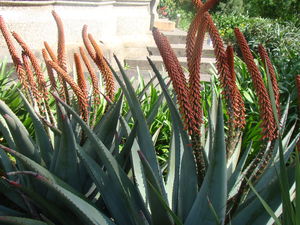

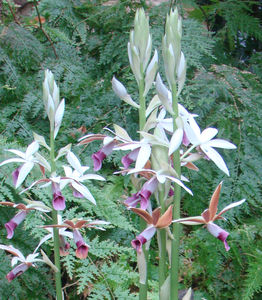









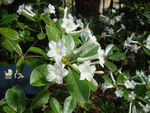
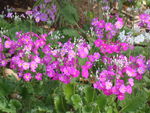

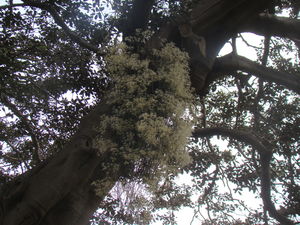
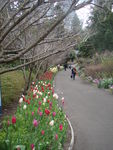

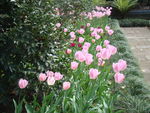

/http%3A%2F%2Fstorage.canalblog.com%2F58%2F55%2F658942%2F119685714_o.jpg)
/http%3A%2F%2Fstorage.canalblog.com%2F28%2F49%2F658942%2F116801743_o.jpg)
/http%3A%2F%2Fstorage.canalblog.com%2F78%2F71%2F658942%2F98849878_o.jpg)
/http%3A%2F%2Fstorage.canalblog.com%2F64%2F83%2F658942%2F89294224_o.jpg)